Like a lot of you I am new at this game and would like to share some of my experiences. During this 2007 Christmas Season I began actively looking at tents to replace one for dog agility trials when my Beamer and I get back on the road. I was looking for the best deal in the house, for around $200. We wanted one that we could stand in, with plenty of room for two people and their gear, including the crates for our dogs.
Before we begin a word of caution. Using the internet really lets you know of the tent and their prices. But, look to the home site of the manufacturer for a MSRP because with a lot of the sellers they really jack up the prices and then give you little discounts. You can get a better view of the pricing by staying with Cabelas, Backcountry Edge, Bob Wards and companies like that. DonÂt be fooled; check the internet.
Most tents claims of "sleeps X persons" are inflated and usable space should include allowances for about six square feet of baggage for each adult. Consumer Reports found in their tests that when it states the tent fits eight people, one should plan on stacking everyone like cordwood - or stowing all the gear in the car. More likely, a tent will fit comfortably only two-thirds as many people claimed, and probably half would be a more realistic figure.
I initially had settled on the Kelty Trails Dome 6 or Columbia Bugaboo Dome tents (because at my age we won't be going too far afield) but then I looked at the Eureka tents. I even went to Consumers Reports and found that the Eureka Sunrise 9 offered the best ventilation of all tents tested. But, for many more extra dollars EurekaÂs Titan does buy more room, easier setup, aluminum poles instead of fiberglass, and two doors instead of one. Kelty was not figured in their reports, nor was Columbia. So I compared them all.
When you consider the Kelty Green River 4 tent, you need to compare it with other KeltyÂs, particularly their Trails Dome 6. But at the same time, we should be looking at a little more inexpensive Columbia Bugaboo dome tent, as well as the Eureka tents. They all have about the same "footprint," about 10Â x 10Â, or 80 to 100 square feet. While the Green River has only 81 square feet, it does have a vestibule, or covered area. It is not included in the sleeping section but can be used for additional storage or folding chairs, to sit under out of the way from the flying bugs. The Eureka Sunrise 9 is also 81 square feet, but it has no vestibule, while their Sunrise 11 has 121 square feet.
The Green RiverÂs vestibule area doesnÂt have a "footprint," or an area that is included as part of the "sealed tub floor." ItÂs outdoors, but could be covered by another drop cloth. That can be a problem with rainy weather - a covered space but with no flooring. But letÂs face it, the extra space of the Columbia Bugaboo actually is the storage, or the "foot lockers" of the tent, and could rightly be included as part of a vestibule (albeit, unlike the Green River, part of the tub), which the Bugaboo and Trails Dome tents do not have.
If weight is a factor, the Trails Dome 6 comes in at only a little over 13 pounds, the Eureka Sunrise 9 is 16 and four ounces, while the other two tents are significantly heavier - both at better than 21 pounds  but if the tent is used for car camping that should not be problematic. But if you want to backpack the additional eight pounds can be quite a lot.
Each tent has sealed seam flooring, generally made of nylon taffeta. But newer models of the Eureka Sunrise have heavy duty 210 denier polyester oxford cloth for its tub flooring. Although the Columbia tent appears to be made of somewhat lighter material than the two Kelty tents, it has a polyethylene floor. Also, both the Kelty tents are seamless floor areas while the Columbia does have a sealed seam which may become a problem. The Kelty and Eureka tents tub design does appears a bit better, keeping the seams watertight and above the ground.
The Eureka Sunrise tents have an excellent design for a "bathtub floor" since it means that there is no seam at ground level to leak during a rainy trip. However, it means there is a horizontal seam all the way around that is not covered by the fly. When it rains, those seam leaks. It's not a flood, but it most certainly is a design flaw in that it could have been lined or double-stitched to prevent this, or the fly could be bigger to cover that seam, so water rolling off the fly wouldn't roll down the sides of the tent. The vertical corners seams above the floor line also leak a bit, but not half as bad as the horizontal seam.
My so-far-short-term solution has been to use up an entire can of seam sealer spray on the exposed horizontal and vertical seams. That seems to have done the trick for now, but we'll see if it holds up come spring.
With Kelty's ArcEdge construction for their tents, the floor seams are lifted up off the ground to prevent water seepage around the floor/wall seams. Kelty's water tight wall technology uses a shingled seam approach. Kelty has also installed flaps over the exposed windows and doors to prevent leakage at the zippers even in high wind.
The major difference seems to be the use of the DAC DA 17 poles with KeltyÂs Trail dome tent. The others make use of fiberglass poles, two 9.5 mm for Columbia Bugaboo and three 11 mm poles for the Green River, and the Eureka Sunrise uses two 11 mm poles with ring and pin attachment. The Trails Dome has two 14.5 mm aluminum poles (7000), and two 9 mm aluminum brow poles over the awnings covering the doors (but you may find older stock with fiberglass brow poles). The poles found on the Trail Dome 6 are lighter, stronger and longer lasting than fiberglass poles. Aluminum poles are more durable to handle heavy wind and snow loads. Unlike fiberglass, aluminum does not become brittle in cold weather and they are heavier, but the pre-formed aluminum ones come at a significantly higher price. The fiberglass would probably be fine for the not too frequent camper.
The Kelty tents offer heavier Nylon cloth construction for the tents. It appears that between them, the 1800 mm coating on the flooring of the KeltyÂs would possibly be a better buy than the 1200 mm that goes with the Columbia, even if it is double coated. The 70-denier fabric appears to be better on the two Kelty tents. The Kelty comes with different fabrics for its walls and fly, being a 68 denier for the walls but a generous 75 denier poly rip-stop for the fly. The Eureka uses heavier fabrics: 75D poly for the walls and Fly, with a triple dose of 1200 mm for their Storm Shield coatings. The industry standard for waterproof rain flies are all constructed of polyester taffeta with 800 mm coatings, but both Kelty tents have 1800 mm waterproof ratings while it is 1200 mm for the Columbia Bugaboo and the Eureka Sunrise.
Except for the Eureka, each of the tents has sleeves and clips - rather than just sleeves to put the poles through. While it makes it easier to erect, there may a problem in high wind areas for them. The Sunrise 9 uses a pin and ring system to attach the 11 mm fiberglass poles, while the Sunrise 11 makes do with 12.7 mm poles. Because they are all dome tents this may be less of a concern, but the Green River will be harder for a single person to set up in that there are three poles rather than two. In reviewing as many comments on tents as possible this is one area that seems to detract from the Green River. The complicated and difficulty in setting up was a major complaint and must be considered.
The Columbia Bugaboo, unlike the Trails Dome, makes use of large scale no-see-um mesh instead of another door and calls this mesh window with a skylight its Cyclone Venting System. For warm weather camping, like here in UtahÂs desert county, it appears to make a lot of sense. However, both the KeltyÂs do have very good ventilation, and should not be problematic. And the Eureka has four hooded zippered windows which allows quite a bit of ventilation or privacy.
All the tents come with a fly cover, which would be nicer if it was bigger on the Sunrise tents (i.e., extended all the way over the entire tent). This fly must be used overnight, as the entire top of the tent is screen and without a fly, you'd get soaked in the lightest rain. Where we go there is always that chance, and one time at a dog agility trial the sprinkler system came on during the night.
I am retired and with my companion have taken up agility as a dog-handler team and spend a few weekends at trials. I would like to camp out (something that I left behind 55 years ago, in Korea and swore I would never do it again) and tried it this summer and fall, but with a smaller one person tent. And we found out that the high Sierras is not an area to be caught in during the fall snow storms that came about last October. We really don't need a screened vestibule area, but would like a little more room to wander - with headroom to squander like in the Bugaboo and Trails Dome. And we don't need a Springbar tent - not at this age!
For me, the decision settled down to the Eureka Sunrise 11 and the Kelty Trail Dome 6 tent. They both had desirable features, but the aluminum poles and weight of the Trail Dome 6 would have won out  except for the cost. But I did find out that there are big changes in store for the Trail Dome, but could not get the information from Kelty. They do have on their website some pictures of the tent slated for 2008, and they are significantly different than those that came out in 2005.
I would give each of these tents a 5.0, but because they individually have features that would be nice but are lacking at this time, I rated them both at 4.5, and went with the EUREKA SUNRISE 11 for its height and the extra space, better ventilation with larger windows, and the good tub design and better fabric covering for the the floor.
And I liked the color, but Beamer could care less.













wareaglecamper
tplife
Related Discussions
How to introduce tent camping to newbies?
Q
Tent reco....4 people...rain proof...under $150
Q
Are tweeter materials important.? I have aluminum dome ones and
Q
In search of brown/blue pillow for family room
Q
betty43
tplife
grannycamper
campingnewbee
cezzzz